Parties to the Collective Bargaining Process
VerifiedAdded on 2022/11/27
|7
|1568
|490
AI Summary
This document discusses the parties involved in the collective bargaining process, including the role of employee and employer representatives. It also explores the management right clause and its implications, profit sharing plans and cost of living adjustments, the use of seniority in layoffs, union membership in the US in 2009, and surface bargaining and the role of the NLBR.
Contribute Materials
Your contribution can guide someone’s learning journey. Share your
documents today.
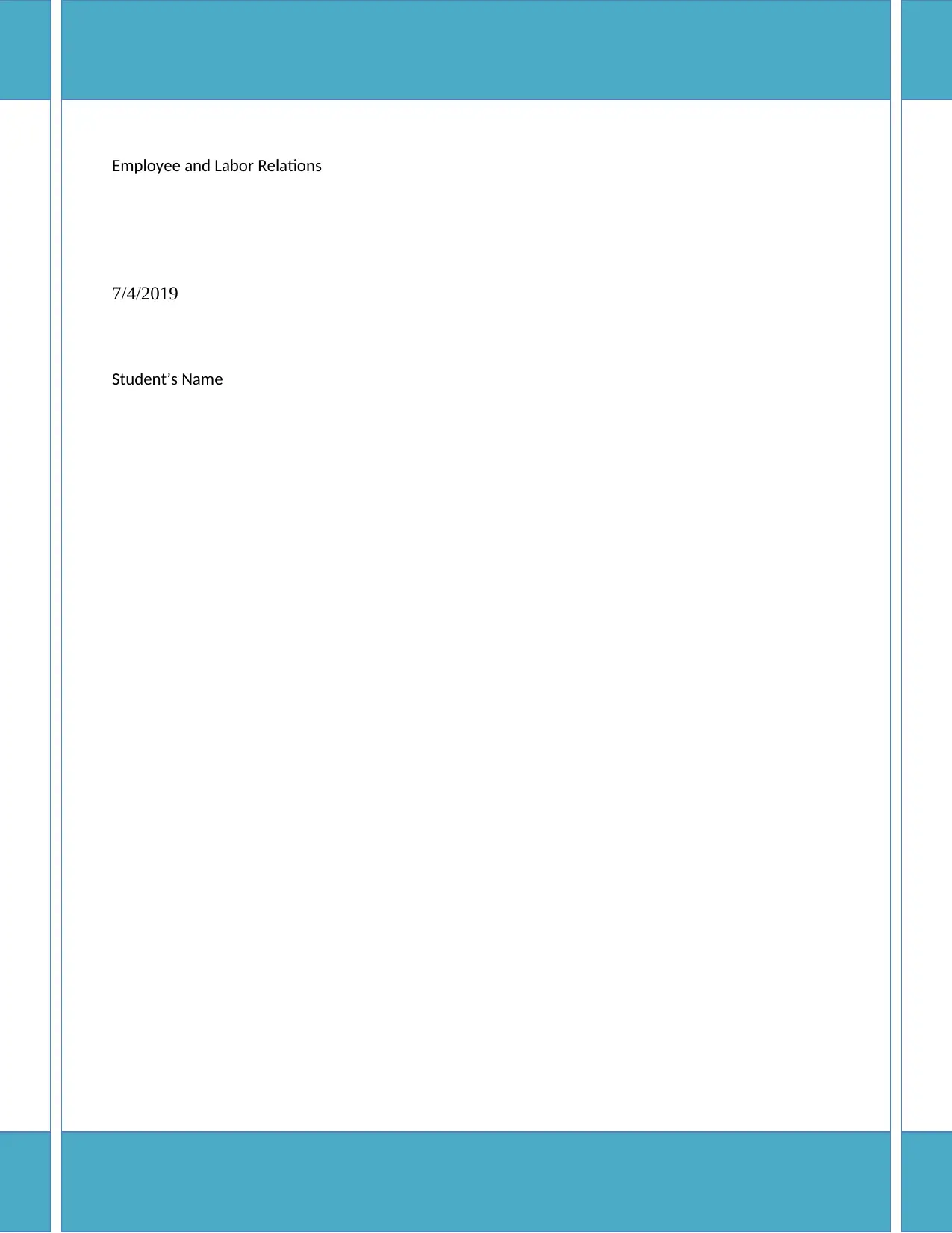
Employee and Labor Relations
7/4/2019
Student’s Name
7/4/2019
Student’s Name
Secure Best Marks with AI Grader
Need help grading? Try our AI Grader for instant feedback on your assignments.
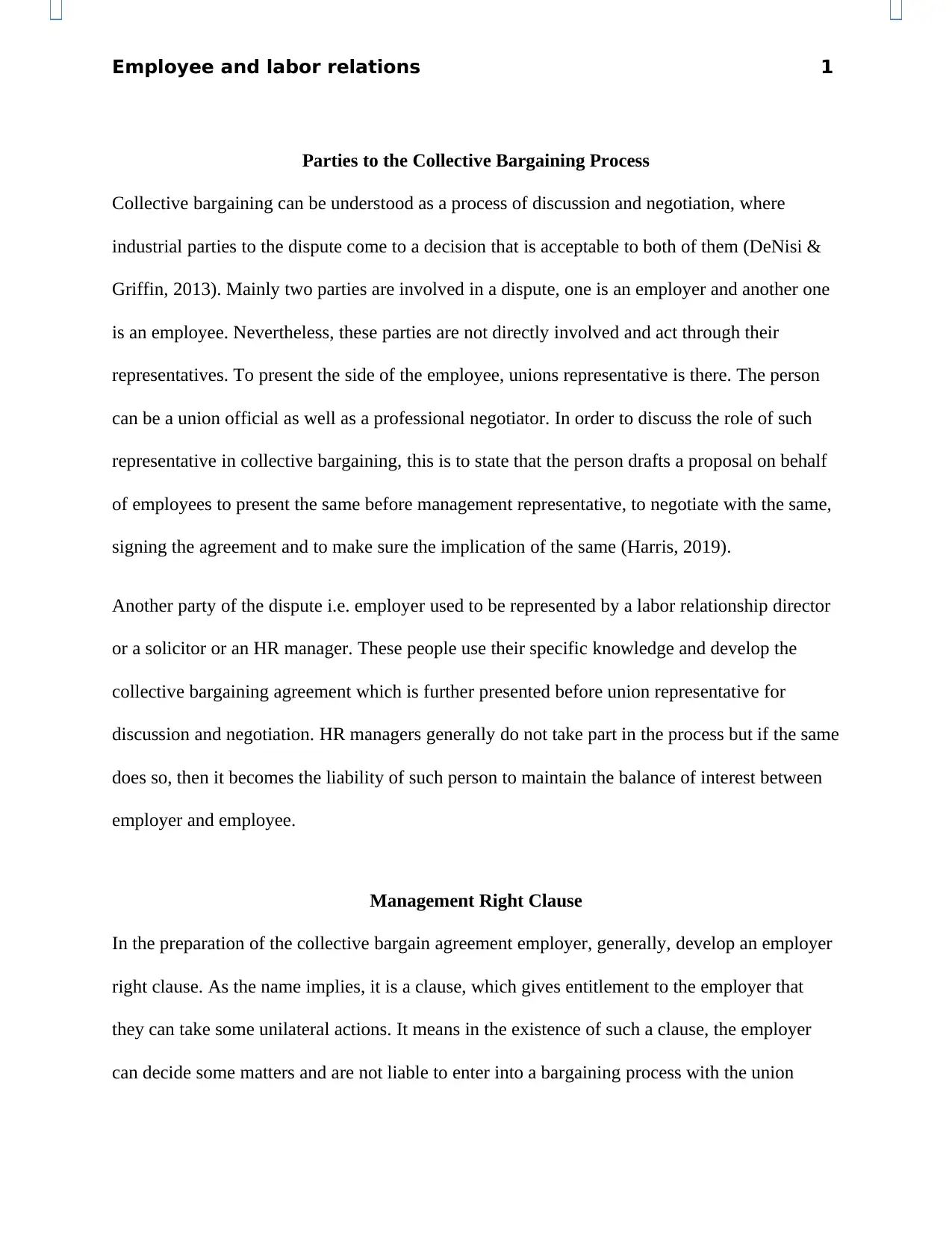
Employee and labor relations 1
Parties to the Collective Bargaining Process
Collective bargaining can be understood as a process of discussion and negotiation, where
industrial parties to the dispute come to a decision that is acceptable to both of them (DeNisi &
Griffin, 2013). Mainly two parties are involved in a dispute, one is an employer and another one
is an employee. Nevertheless, these parties are not directly involved and act through their
representatives. To present the side of the employee, unions representative is there. The person
can be a union official as well as a professional negotiator. In order to discuss the role of such
representative in collective bargaining, this is to state that the person drafts a proposal on behalf
of employees to present the same before management representative, to negotiate with the same,
signing the agreement and to make sure the implication of the same (Harris, 2019).
Another party of the dispute i.e. employer used to be represented by a labor relationship director
or a solicitor or an HR manager. These people use their specific knowledge and develop the
collective bargaining agreement which is further presented before union representative for
discussion and negotiation. HR managers generally do not take part in the process but if the same
does so, then it becomes the liability of such person to maintain the balance of interest between
employer and employee.
Management Right Clause
In the preparation of the collective bargain agreement employer, generally, develop an employer
right clause. As the name implies, it is a clause, which gives entitlement to the employer that
they can take some unilateral actions. It means in the existence of such a clause, the employer
can decide some matters and are not liable to enter into a bargaining process with the union
Parties to the Collective Bargaining Process
Collective bargaining can be understood as a process of discussion and negotiation, where
industrial parties to the dispute come to a decision that is acceptable to both of them (DeNisi &
Griffin, 2013). Mainly two parties are involved in a dispute, one is an employer and another one
is an employee. Nevertheless, these parties are not directly involved and act through their
representatives. To present the side of the employee, unions representative is there. The person
can be a union official as well as a professional negotiator. In order to discuss the role of such
representative in collective bargaining, this is to state that the person drafts a proposal on behalf
of employees to present the same before management representative, to negotiate with the same,
signing the agreement and to make sure the implication of the same (Harris, 2019).
Another party of the dispute i.e. employer used to be represented by a labor relationship director
or a solicitor or an HR manager. These people use their specific knowledge and develop the
collective bargaining agreement which is further presented before union representative for
discussion and negotiation. HR managers generally do not take part in the process but if the same
does so, then it becomes the liability of such person to maintain the balance of interest between
employer and employee.
Management Right Clause
In the preparation of the collective bargain agreement employer, generally, develop an employer
right clause. As the name implies, it is a clause, which gives entitlement to the employer that
they can take some unilateral actions. It means in the existence of such a clause, the employer
can decide some matters and are not liable to enter into a bargaining process with the union
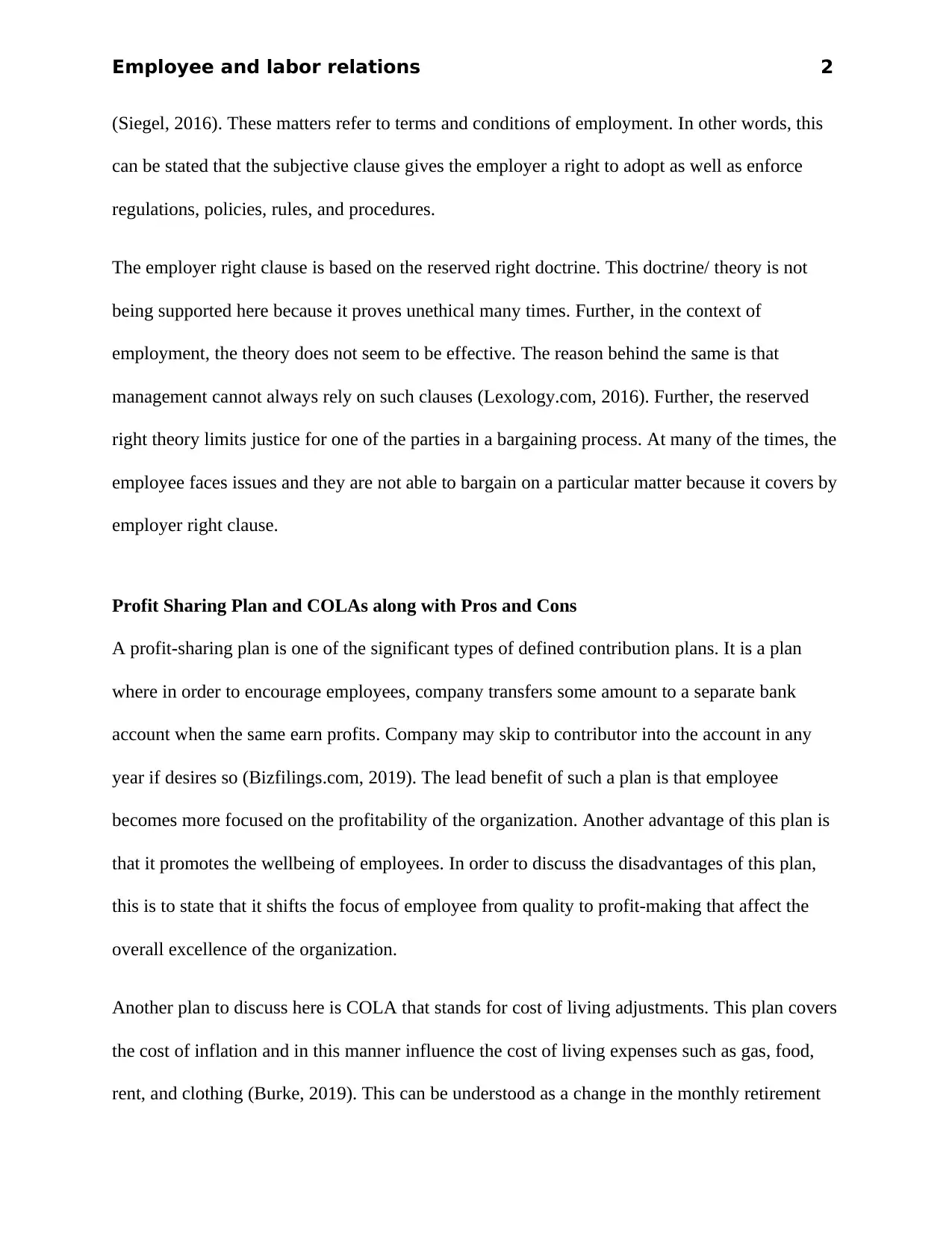
Employee and labor relations 2
(Siegel, 2016). These matters refer to terms and conditions of employment. In other words, this
can be stated that the subjective clause gives the employer a right to adopt as well as enforce
regulations, policies, rules, and procedures.
The employer right clause is based on the reserved right doctrine. This doctrine/ theory is not
being supported here because it proves unethical many times. Further, in the context of
employment, the theory does not seem to be effective. The reason behind the same is that
management cannot always rely on such clauses (Lexology.com, 2016). Further, the reserved
right theory limits justice for one of the parties in a bargaining process. At many of the times, the
employee faces issues and they are not able to bargain on a particular matter because it covers by
employer right clause.
Profit Sharing Plan and COLAs along with Pros and Cons
A profit-sharing plan is one of the significant types of defined contribution plans. It is a plan
where in order to encourage employees, company transfers some amount to a separate bank
account when the same earn profits. Company may skip to contributor into the account in any
year if desires so (Bizfilings.com, 2019). The lead benefit of such a plan is that employee
becomes more focused on the profitability of the organization. Another advantage of this plan is
that it promotes the wellbeing of employees. In order to discuss the disadvantages of this plan,
this is to state that it shifts the focus of employee from quality to profit-making that affect the
overall excellence of the organization.
Another plan to discuss here is COLA that stands for cost of living adjustments. This plan covers
the cost of inflation and in this manner influence the cost of living expenses such as gas, food,
rent, and clothing (Burke, 2019). This can be understood as a change in the monthly retirement
(Siegel, 2016). These matters refer to terms and conditions of employment. In other words, this
can be stated that the subjective clause gives the employer a right to adopt as well as enforce
regulations, policies, rules, and procedures.
The employer right clause is based on the reserved right doctrine. This doctrine/ theory is not
being supported here because it proves unethical many times. Further, in the context of
employment, the theory does not seem to be effective. The reason behind the same is that
management cannot always rely on such clauses (Lexology.com, 2016). Further, the reserved
right theory limits justice for one of the parties in a bargaining process. At many of the times, the
employee faces issues and they are not able to bargain on a particular matter because it covers by
employer right clause.
Profit Sharing Plan and COLAs along with Pros and Cons
A profit-sharing plan is one of the significant types of defined contribution plans. It is a plan
where in order to encourage employees, company transfers some amount to a separate bank
account when the same earn profits. Company may skip to contributor into the account in any
year if desires so (Bizfilings.com, 2019). The lead benefit of such a plan is that employee
becomes more focused on the profitability of the organization. Another advantage of this plan is
that it promotes the wellbeing of employees. In order to discuss the disadvantages of this plan,
this is to state that it shifts the focus of employee from quality to profit-making that affect the
overall excellence of the organization.
Another plan to discuss here is COLA that stands for cost of living adjustments. This plan covers
the cost of inflation and in this manner influence the cost of living expenses such as gas, food,
rent, and clothing (Burke, 2019). This can be understood as a change in the monthly retirement
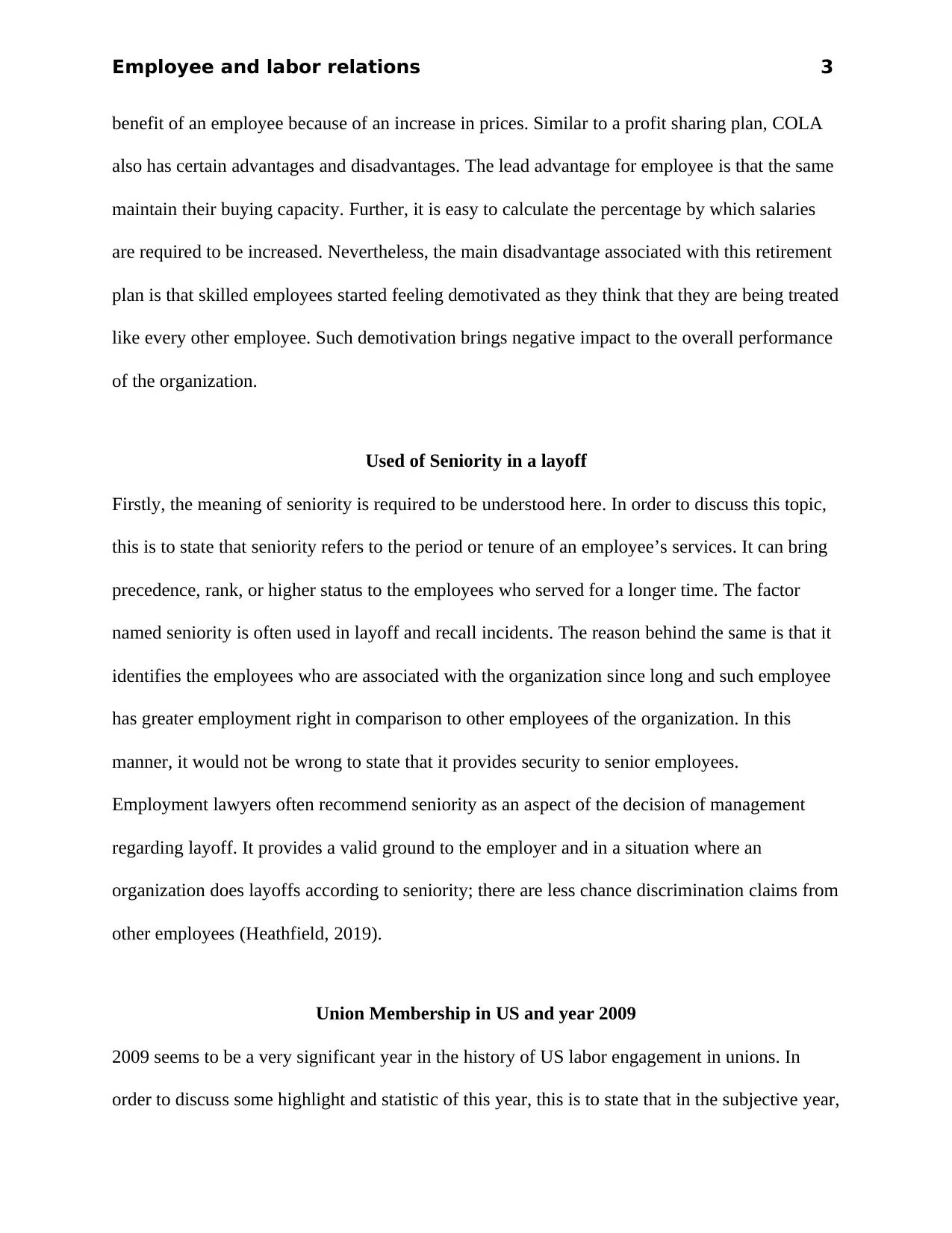
Employee and labor relations 3
benefit of an employee because of an increase in prices. Similar to a profit sharing plan, COLA
also has certain advantages and disadvantages. The lead advantage for employee is that the same
maintain their buying capacity. Further, it is easy to calculate the percentage by which salaries
are required to be increased. Nevertheless, the main disadvantage associated with this retirement
plan is that skilled employees started feeling demotivated as they think that they are being treated
like every other employee. Such demotivation brings negative impact to the overall performance
of the organization.
Used of Seniority in a layoff
Firstly, the meaning of seniority is required to be understood here. In order to discuss this topic,
this is to state that seniority refers to the period or tenure of an employee’s services. It can bring
precedence, rank, or higher status to the employees who served for a longer time. The factor
named seniority is often used in layoff and recall incidents. The reason behind the same is that it
identifies the employees who are associated with the organization since long and such employee
has greater employment right in comparison to other employees of the organization. In this
manner, it would not be wrong to state that it provides security to senior employees.
Employment lawyers often recommend seniority as an aspect of the decision of management
regarding layoff. It provides a valid ground to the employer and in a situation where an
organization does layoffs according to seniority; there are less chance discrimination claims from
other employees (Heathfield, 2019).
Union Membership in US and year 2009
2009 seems to be a very significant year in the history of US labor engagement in unions. In
order to discuss some highlight and statistic of this year, this is to state that in the subjective year,
benefit of an employee because of an increase in prices. Similar to a profit sharing plan, COLA
also has certain advantages and disadvantages. The lead advantage for employee is that the same
maintain their buying capacity. Further, it is easy to calculate the percentage by which salaries
are required to be increased. Nevertheless, the main disadvantage associated with this retirement
plan is that skilled employees started feeling demotivated as they think that they are being treated
like every other employee. Such demotivation brings negative impact to the overall performance
of the organization.
Used of Seniority in a layoff
Firstly, the meaning of seniority is required to be understood here. In order to discuss this topic,
this is to state that seniority refers to the period or tenure of an employee’s services. It can bring
precedence, rank, or higher status to the employees who served for a longer time. The factor
named seniority is often used in layoff and recall incidents. The reason behind the same is that it
identifies the employees who are associated with the organization since long and such employee
has greater employment right in comparison to other employees of the organization. In this
manner, it would not be wrong to state that it provides security to senior employees.
Employment lawyers often recommend seniority as an aspect of the decision of management
regarding layoff. It provides a valid ground to the employer and in a situation where an
organization does layoffs according to seniority; there are less chance discrimination claims from
other employees (Heathfield, 2019).
Union Membership in US and year 2009
2009 seems to be a very significant year in the history of US labor engagement in unions. In
order to discuss some highlight and statistic of this year, this is to state that in the subjective year,
Secure Best Marks with AI Grader
Need help grading? Try our AI Grader for instant feedback on your assignments.
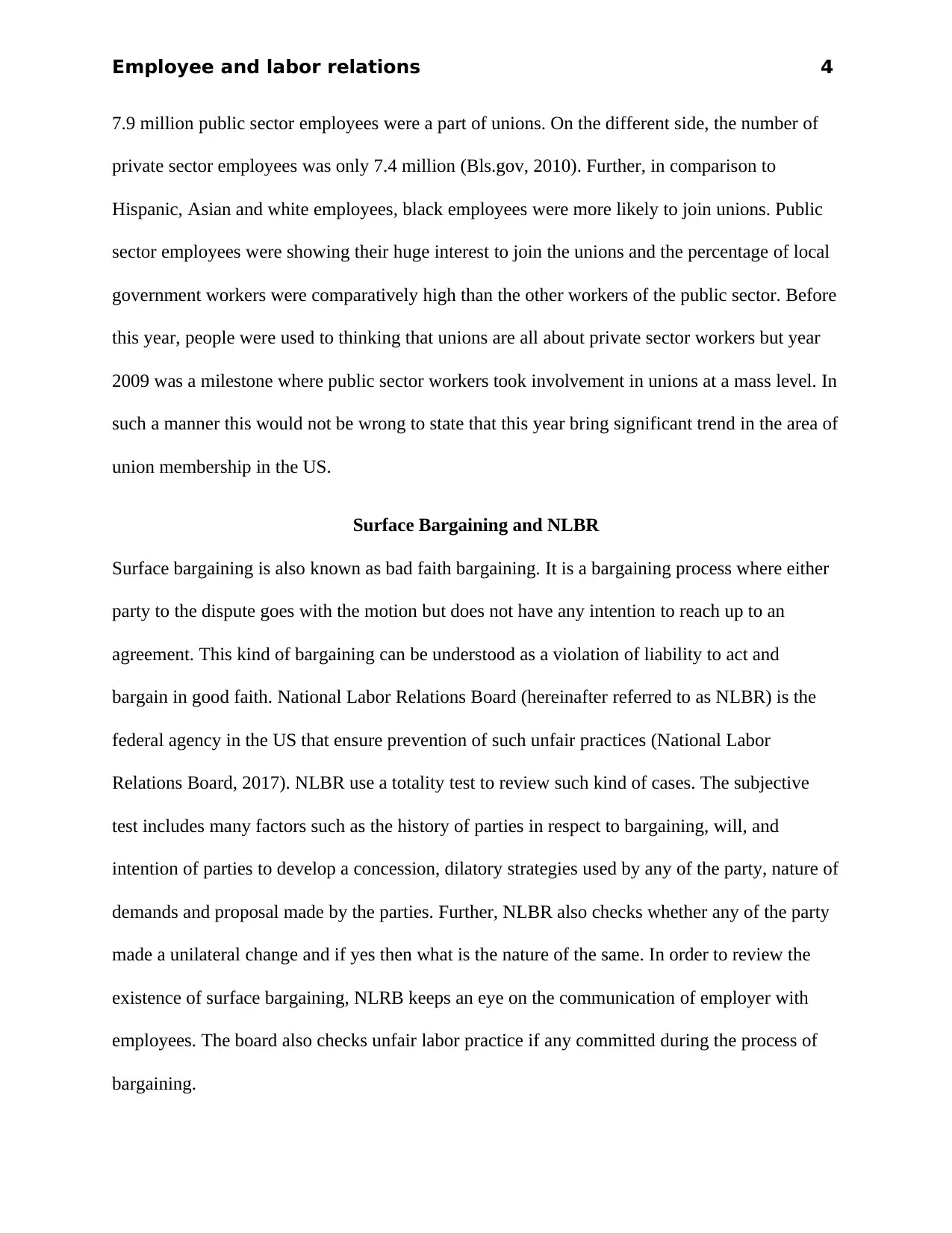
Employee and labor relations 4
7.9 million public sector employees were a part of unions. On the different side, the number of
private sector employees was only 7.4 million (Bls.gov, 2010). Further, in comparison to
Hispanic, Asian and white employees, black employees were more likely to join unions. Public
sector employees were showing their huge interest to join the unions and the percentage of local
government workers were comparatively high than the other workers of the public sector. Before
this year, people were used to thinking that unions are all about private sector workers but year
2009 was a milestone where public sector workers took involvement in unions at a mass level. In
such a manner this would not be wrong to state that this year bring significant trend in the area of
union membership in the US.
Surface Bargaining and NLBR
Surface bargaining is also known as bad faith bargaining. It is a bargaining process where either
party to the dispute goes with the motion but does not have any intention to reach up to an
agreement. This kind of bargaining can be understood as a violation of liability to act and
bargain in good faith. National Labor Relations Board (hereinafter referred to as NLBR) is the
federal agency in the US that ensure prevention of such unfair practices (National Labor
Relations Board, 2017). NLBR use a totality test to review such kind of cases. The subjective
test includes many factors such as the history of parties in respect to bargaining, will, and
intention of parties to develop a concession, dilatory strategies used by any of the party, nature of
demands and proposal made by the parties. Further, NLBR also checks whether any of the party
made a unilateral change and if yes then what is the nature of the same. In order to review the
existence of surface bargaining, NLRB keeps an eye on the communication of employer with
employees. The board also checks unfair labor practice if any committed during the process of
bargaining.
7.9 million public sector employees were a part of unions. On the different side, the number of
private sector employees was only 7.4 million (Bls.gov, 2010). Further, in comparison to
Hispanic, Asian and white employees, black employees were more likely to join unions. Public
sector employees were showing their huge interest to join the unions and the percentage of local
government workers were comparatively high than the other workers of the public sector. Before
this year, people were used to thinking that unions are all about private sector workers but year
2009 was a milestone where public sector workers took involvement in unions at a mass level. In
such a manner this would not be wrong to state that this year bring significant trend in the area of
union membership in the US.
Surface Bargaining and NLBR
Surface bargaining is also known as bad faith bargaining. It is a bargaining process where either
party to the dispute goes with the motion but does not have any intention to reach up to an
agreement. This kind of bargaining can be understood as a violation of liability to act and
bargain in good faith. National Labor Relations Board (hereinafter referred to as NLBR) is the
federal agency in the US that ensure prevention of such unfair practices (National Labor
Relations Board, 2017). NLBR use a totality test to review such kind of cases. The subjective
test includes many factors such as the history of parties in respect to bargaining, will, and
intention of parties to develop a concession, dilatory strategies used by any of the party, nature of
demands and proposal made by the parties. Further, NLBR also checks whether any of the party
made a unilateral change and if yes then what is the nature of the same. In order to review the
existence of surface bargaining, NLRB keeps an eye on the communication of employer with
employees. The board also checks unfair labor practice if any committed during the process of
bargaining.
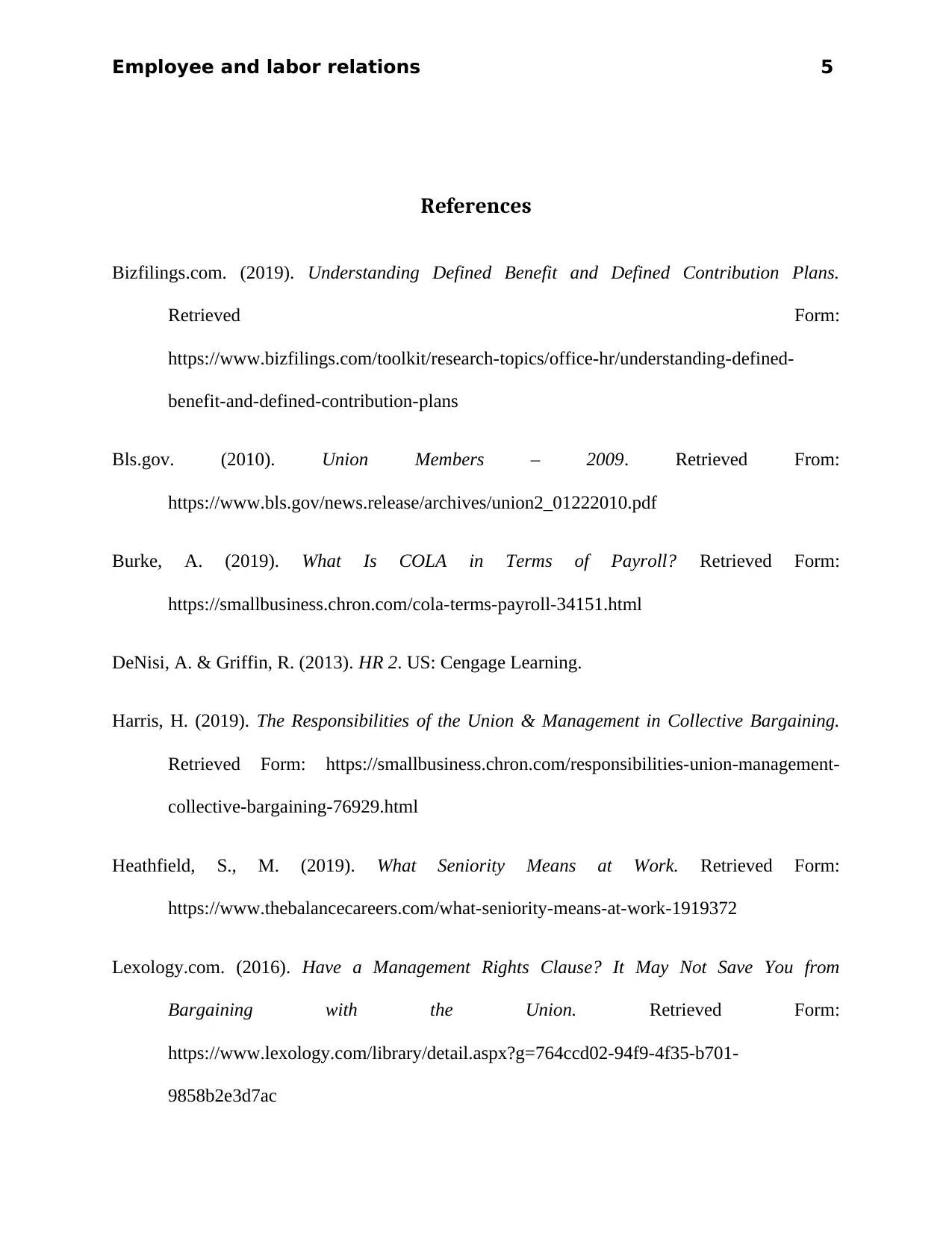
Employee and labor relations 5
References
Bizfilings.com. (2019). Understanding Defined Benefit and Defined Contribution Plans.
Retrieved Form:
https://www.bizfilings.com/toolkit/research-topics/office-hr/understanding-defined-
benefit-and-defined-contribution-plans
Bls.gov. (2010). Union Members – 2009. Retrieved From:
https://www.bls.gov/news.release/archives/union2_01222010.pdf
Burke, A. (2019). What Is COLA in Terms of Payroll? Retrieved Form:
https://smallbusiness.chron.com/cola-terms-payroll-34151.html
DeNisi, A. & Griffin, R. (2013). HR 2. US: Cengage Learning.
Harris, H. (2019). The Responsibilities of the Union & Management in Collective Bargaining.
Retrieved Form: https://smallbusiness.chron.com/responsibilities-union-management-
collective-bargaining-76929.html
Heathfield, S., M. (2019). What Seniority Means at Work. Retrieved Form:
https://www.thebalancecareers.com/what-seniority-means-at-work-1919372
Lexology.com. (2016). Have a Management Rights Clause? It May Not Save You from
Bargaining with the Union. Retrieved Form:
https://www.lexology.com/library/detail.aspx?g=764ccd02-94f9-4f35-b701-
9858b2e3d7ac
References
Bizfilings.com. (2019). Understanding Defined Benefit and Defined Contribution Plans.
Retrieved Form:
https://www.bizfilings.com/toolkit/research-topics/office-hr/understanding-defined-
benefit-and-defined-contribution-plans
Bls.gov. (2010). Union Members – 2009. Retrieved From:
https://www.bls.gov/news.release/archives/union2_01222010.pdf
Burke, A. (2019). What Is COLA in Terms of Payroll? Retrieved Form:
https://smallbusiness.chron.com/cola-terms-payroll-34151.html
DeNisi, A. & Griffin, R. (2013). HR 2. US: Cengage Learning.
Harris, H. (2019). The Responsibilities of the Union & Management in Collective Bargaining.
Retrieved Form: https://smallbusiness.chron.com/responsibilities-union-management-
collective-bargaining-76929.html
Heathfield, S., M. (2019). What Seniority Means at Work. Retrieved Form:
https://www.thebalancecareers.com/what-seniority-means-at-work-1919372
Lexology.com. (2016). Have a Management Rights Clause? It May Not Save You from
Bargaining with the Union. Retrieved Form:
https://www.lexology.com/library/detail.aspx?g=764ccd02-94f9-4f35-b701-
9858b2e3d7ac

Employee and labor relations 6
Siegel, K. (2016). NLRB Requires Specificity in Management-Rights Clauses. Retrieved Form:
https://www.littler.com/publication-press/publication/nlrb-requires-specificity-
management-rights-clauses
Siegel, K. (2016). NLRB Requires Specificity in Management-Rights Clauses. Retrieved Form:
https://www.littler.com/publication-press/publication/nlrb-requires-specificity-
management-rights-clauses
1 out of 7
Related Documents
Your All-in-One AI-Powered Toolkit for Academic Success.
+13062052269
info@desklib.com
Available 24*7 on WhatsApp / Email
![[object Object]](/_next/static/media/star-bottom.7253800d.svg)
Unlock your academic potential
© 2024 | Zucol Services PVT LTD | All rights reserved.





